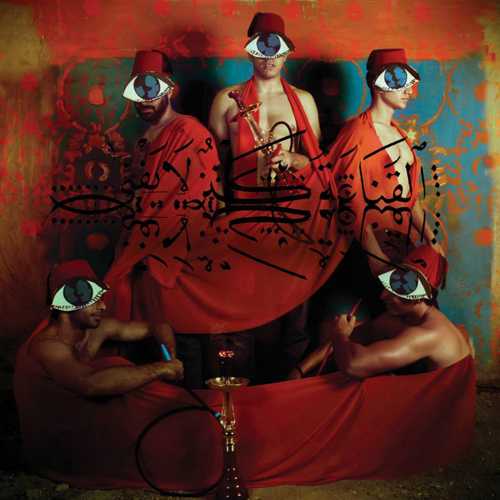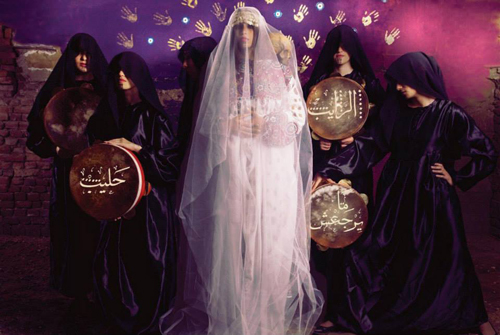The slightest commotion on Cairo's streets usually draws crowds of varying sizes, their prying eyes eager to find out who is going where, who is wearing what or screaming at whom, and whether or not there is blood. This time, a crowd gathered outside the Safarkhan Gallery in Zamalek on a Tuesday night, peering into the suddenly vibrant art space with probing looks.
“It is very colourful, for a change,” one visitor announced as she walked into the gallery enclosed by large-scale photographs adorned with brightly coloured flowers, figures, and decorative motifs. For a minute, it feels like walking through a field of roses, or being trapped in a green house.
In his first solo exhibition, entitled 'O.M.G', which opened 27 November at Safarkhan Gallery, contemporary artist Bassem Samir showcases a collection of heavily stylised conceptual photographs addressing contemporary Egyptian culture and the state of chaos that pervades it.
Bassem Samir graduated with a degree in Fine Arts from the University of Alexandria in 2006. He has since participated in a number of collective exhibitions in Cairo, Alexandria, as well as overseas: Hamburg, Frankfurt (Germany), Doha (Qatar) and Athens (Greece).
The composition of the photographs follows the same formula across the collection: figures or objects are juxtaposed against hand-painted backgrounds, with calligraphy strategically inscribed in different locations on the image, adding folkloric proverbs to the vibrant images. The artist premeditates every detail.
These photographed installations are submerged in colour and symbolism. Interlaced in the decorative compositions are cultural references that tackle Egypt’s multi-layered heritage, Pharaonic drawings, geometric Islamic motifs, Coptic symbols, folkloric proverbs, and even a modern-day toktok (rickshaw) making its way into Samir’s collection.
“I am trying to present the lack of identity and chaos that has characterised contemporary Egyptian culture,” Samir tells Ahram Online.
By inserting a myriad of historical cultural motifs, Samir ridicules a contemporary culture that pales in comparison. He has been closely observing a country radically transforming across the past few years and in a sophisticated visual language reveals his disapproval with the status quo.
Bassem Samir first sketched out the idea for this artistic endeavour three years ago. While meeting artist and curator Yara Mekawi to discuss his participation in a group show scheduled to take place towards the end of 2010, Samir, who had just flown in from London, and generally rejected anything Egyptian, made the uncharacteristic suggestion that they embark on a walk around downtown Cairo. "I was mesmerised by the houses and the streets; I noticed how much beauty there is in our country," he reminisces.
“Before 2011, my artistic style was very Western,” he explains. “But after the revolution, I was inspired by the work on the street, and so I brought it into this new series.”
The layers of posters, graffiti and colours strewn across the city’s walls as the uprising unfolded created a texture and visual effect that Samir attempted to recreate in his heavily stylised photographs.
Contemporary American photographer and director David LaChapelle, recognised for a surreal, eroticised style, as well as British fashion photographer Tim Walker, have also heavily influenced Samir.
In 'O.M.G.', Samir combines a surrealist aesthetic with profound social messages. In a colourful, compounded style packed with clashing cultural references and motifs, Samir's collection presents an iconoclastic act in the critical discourse over Egypt’s contemporary society.
He takes issue with “the overuse of the English language, the oppressive marriage culture, ridiculous government projects such as the toktok and the way society has become hopelessly divided,” he explains.
"I am shocked with reality, and I just want to start a dialogue," says Samir.
In preparation for this exhibition, Samir received support and advice from an assortment of Egyptian artists working within varying fields, including film directors Amr Salama, Marwan Hamed and visual artist Khaled Hafez.
Setting out to capture and present the chaos inundating contemporary society, Samir worked for months on end in a garage that resembled a dump, which he said provided an extremely rich working environment.
The artist was keen on creating an elaborate mise-en-scène for every photograph. He retained a dramatic irony throughout however, instructing the models to assume unorthodox positions and surrender to quirky outfits while the artist collected material for the project.
Across the collection, the artist tackles various elements of contemporary society, perhaps most prominent of which is male and female identity against the backdrop of an eroding indigenous culture. Replete with images and symbols, the stories he stages require more than one look to be fully grasped.
In one photograph, five men are wrapped with the same large piece of red fabric, a few of them clutching shishas (hookah) in their strong hands, but all of them wearing the tarboush (traditional red fez), as the upper half of their face is covered in a single caricature eye.

'OMG Boys' by Bassem Samir (Photo: courtesy of Safarkhan Gallery)
With this piece, Samir seems to be commenting on the disappearance of individuality, hence the concealment of facial features while a single cloth enwraps all the men. The penetrating eye of society, forcing men to exhibit symbols of manhood (shisha in this case) to satisfy expected gender roles, also speaks volumes about our current culture. Calligraphy that cuts across the middle of the photograph reads "Contentment is a treasure that does not run out." Samir laughs, "Of course, it is ironic here.”
A recurring element throughout the exhibition is the friction between old and new. The artist decontextualises well-known proverbs that have circulated Egyptian society for decades, juxtaposing them with the images he has created to illustrate this dialogue between the past and precarious present.
In another photograph, a group of women clothed in black dresses with shawls that drape across their eyes stand around a bride with a skull resting casually (and hauntingly) on her shoulder. Here, the artist criticises the "oppressive marriage culture in Egypt," he explains.

'Marriage' by Bassem Samir (Photo: courtesy of Safarkhan Gallery)
A series of four photographs entitled 'O.M.G. Girls' feature female models dressed in patterned dresses that Samir designed himself, with oversized flowers atop their heads, often hiding large portions of their faces. The girls are placed at unusual angels or caught in unlikely positions against brick walls painted in bright colours.
"I designed it in a way so you don't understand if the girl is wearing a galabiya [traditional Egyptian dress] or a cocktail gown," Samir reveals. "I am trying to show the loss of identity through today’s puzzling wardrobe."
Strolling through the exhibition becomes an experience in itself. Samir displays a few of the props used on set, such as the large fabric flowers and a wooden chair painted pink. A video is also screened at the gallery’s first floor, revealing the behind-the-scenes to the creative process.
Ultimately, this collection amounts to the very flamboyant pages of Samir’s journal. To him, art represents "the only way to runaway without leaving home" -- a cathartic vehicle for expression.
Programme:
The exhibition runs until 27 November at the Safarkhan Gallery.
6 Brazil Street, Zamalek, Cairo
Short link: